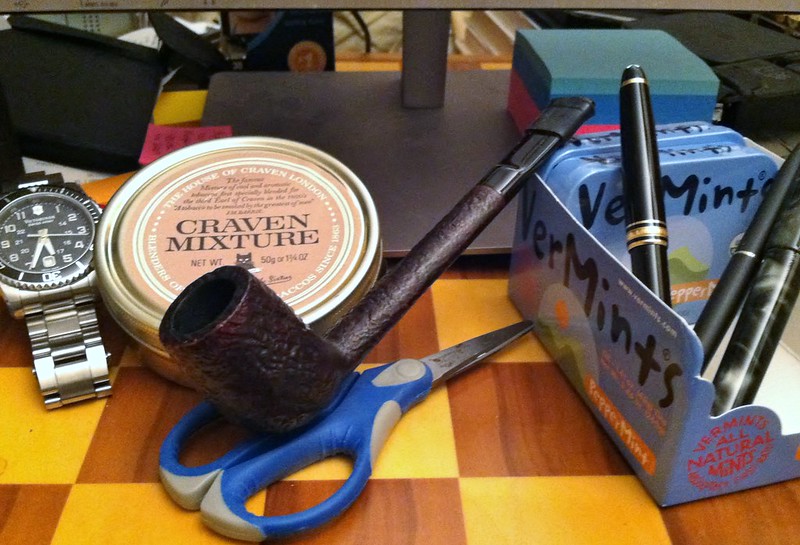Deleted
Deleted Member
Posts: 0
Location:
|
Post by Deleted on Dec 11, 2017 2:26:18 GMT -5
I just bought an estate Barling Garnet Grain 4759 at estatepipeshop.co.uk and can't wait for it to wend its way to me from across the pond. I suppose it's a transition piece from the 1960s but I can't really tell. But I love those Barlings. Will post a photo once I get it.  I hope that the photo is still up on the seller's page and that this link works (it's the full bent one with the "sold" sign on it): link |
|
|
|
Post by JimInks on Dec 11, 2017 3:24:36 GMT -5
It's a later make, but I like the look of it. Hope it's a great smoker for you.
|
|
Deleted
Deleted Member
Posts: 0
Location:
|
Post by Deleted on Dec 11, 2017 8:13:32 GMT -5
Nice looking pipe. Hope you enjoy it.
|
|
Deleted
Deleted Member
Posts: 0
Location:
|
Post by Deleted on Dec 11, 2017 9:08:54 GMT -5
It's a later make, but I like the look of it. Hope it's a great smoker for you. Thanks, Jim. I went back and saw the photo with the stampings, and yes, it's later. From the 1970s, afaik, before the Standard replaced the Garnet Grain designation later in that decade, according to the Pipepedia article. What led me to pull the trigger is that it "looks" like a good smoker. I know that in general terms that is a risky attitude upon which to act, but I have pre-transition Barlings and later ones too, and they're all fine smokers. I'm hoping for the same experience with this one. |
|
|
|
Post by trailboss on Dec 11, 2017 9:40:16 GMT -5
I have what one would call a post transition? Barling Bulldog that I picked up with some estates, it smokes really well.
|
|
|
|
Post by Ronv69 on Dec 11, 2017 11:49:45 GMT -5
I have a couple of the later Barlings. I can find no fault in them. I don't know what the actual differences are supposed to be.
|
|
sablebrush52
Full Member
  
Posts: 903
Favorite Pipe: Barling
Favorite Tobacco: whatever is in it
Location:
|
Post by sablebrush52 on Dec 11, 2017 21:49:51 GMT -5
In general, it's not possible to tell a "Transition" pipe from a "Post-Transition" pipe. The only ones that can be reliably identified as "Transition" pipes are the 1962 "Barling's Make" stamped pipes with the new model numbering system. So when you read someone listing their pipe as a "Transition" pipe, ignore it. That's why I've dropped using these antiquated terms and use Family Era and Corporate Era, as it's much more accurate.
The Garnet Grain series came on the market around November of 1962. The clue to this pipe being later lies in the positioning of the model stamp and the shaping, particularly the slot, which is quite different from the Family Era shaping. Could still be made in the Barling factories in the mid to late 1960's. Could be a great smoker.
As for quality, many of these pipes smoke as well as the Family Era product. But under Imperial's control, the quality became more uneven so the pipes eventually fell out of favor. By the 1970's the Barling factories had been closed, it's staff laid off, and Imperial was outsourcing manufacture to several English manufacturers, including Charatan and Oppenheimer. Later in the '70's, all Barlings were made by Nording. In 1980, Imperial sold the Barling brand to and investment group headed by the former General Manager, Ron Harden, and the operations were moved to the Isle of Mann.
As far as the actual differences are concerned, it comes down to selection of the wood and the processing. Barling's legendary old growth Algerian briar was gone by the mid 1950's a victim of Barling losing their harvesting operations after the Algerian War for Independence. After that, Barling chose wood from a wide range of sources, based on the quality. They were the 800 pound gorilla in the British pipe trade and had first pick.
So the later Family Era product used different wood than the earlier product, but still maintained a very high level of quality in workmanship. Remember that they were largely hand made pipes through 1962, when the Barling family was given the boot. Once Imperial took over direct control in early 1963 the methods for making pipes was streamlined, seasoning was shortened, costs were cut, more experienced carvers were fired, and the quality became less predictable.
|
|
Deleted
Deleted Member
Posts: 0
Location:
|
Post by Deleted on Dec 11, 2017 23:37:20 GMT -5
Appreciate very much that detailed and learned explanation. It's fascinating to delve into the Barling mystery. I have a Barling's Make Ye Old Wood "Fossil" 253 lumberman T.V.F. (photo). The precise dates of manufacture are unknown to me but it's a Barling's Make of the Family Era - whether late or earlier I don't know. I'm interested in Barling history, such as it is.  |
|
